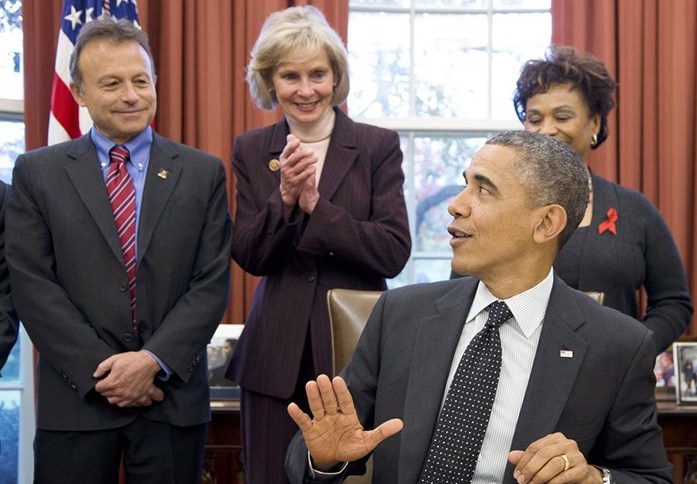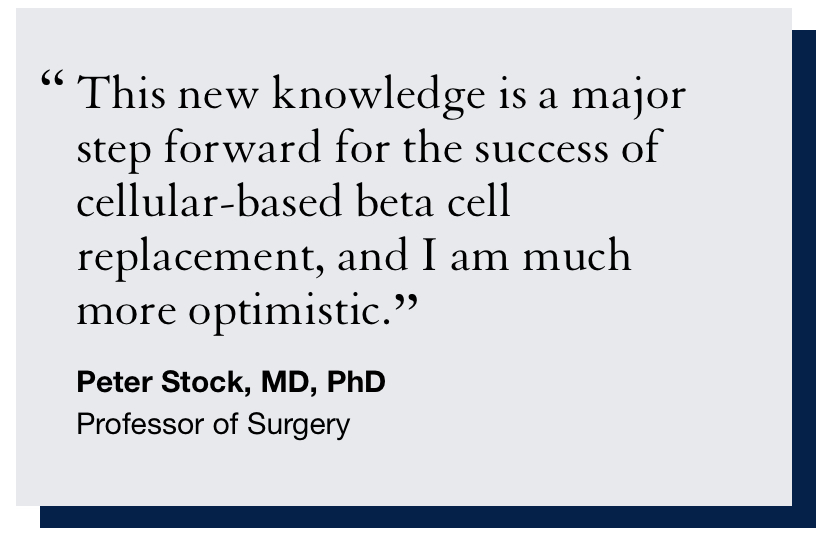Diverse Group of Researchers Help Pioneer Novel Approach to Treating Type 1 Diabetes Using Pancreatic Islets and Parathyroid Gland Co-Transplantation
 Researcher of the Month: Peter Stock, MD, PhD
Researcher of the Month: Peter Stock, MD, PhD
As a pivotal figure in HIV-to-HIV organ transplantation and its legalization through the passage of the HIV Organ Policy Equity (HOPE) Act, transplant surgeon Peter G. Stock, MD., PhD., continues to strive toward breakthroughs in research.
While Stock is mostly known for his HIV transplantation work, he has been investigating pancreatic islet transplantation (also known as beta cell replacement) to cure type 1 diabetes since his days as a PhD student at the University of Minnesota. In May, the California Institute for Regenerative Medicine awarded Stock $11 million for the PARADIGM clinical trial (Pancreatic Islets and Parathyroid Gland Co-transplantation for Treatment of Diabetes in the Intra-Muscular Site). The single-center trial will be conducted at UCSF, which is one of the busiest transplant centers in the U.S.
“We think this trial is going to open the door for stem cell-derived beta cell transplantation in a very non-invasive and retrievable position,” says Stock.
Over the past three decades, clinical trials using islet transplantation in the portal system of the liver have led to patients becoming insulin-independent, but the results are limited. Currently, when islets are infused into the liver, most of them are destroyed before they engraft, which is why less than half the people who undergo an islet transplant have long-term insulin independence.
As the surgical director of UCSF’s Kidney and Pancreas Transplant Program, Stock sees a universal success rate of patients becoming insulin-independent with a technically successful pancreas transplant. But it is a major operation that benefits a small percentage of patients.
“We want to do a procedure that’s safer and simpler, that you could do at a much earlier point in the patient’s disease process so they don’t develop all of the secondary complications of diabetes, such as blindness and kidney failure,” says Stock. “The major problem with both pancreas and islet cell transplants is that the donor source is severely limited and dependent on deceased donors.”
“Stem cell-derived beta cell clusters have the potential for providing an unlimited donor source. The technology is there. The problem with stem cell therapy right now,” Stock explains, “is that you have to be really cautious since stem cell-derived tissue can form neoplasms. It’s a pluripotent cell, so we can’t put it in the liver. We need a retrievable site.”
A lightbulb idea came from surgery resident research fellow Casey Ward, MD, who works with Stock, from the genesis of an idea from UCSF endocrine surgeon Quan-Yang Duh, MD, about the effectiveness of parathyroid tissue.
“Casey thought, ‘We’ve been transplanting parathyroid tissue into the forearm for years. Why does endocrine tissue work in the forearm, but we’ve never been able to get islets to grow there?’ Casey thought about mixing the parathyroid tissue with the islet tissue, and lo and behold, it works – it makes the islet tissue survive,” says Stock.
This new knowledge is a major step forward for the success of cellular-based beta cell replacement, and I am much more optimistic.
 Ward has been co-mentored by Qizhi Tang, PhD, director of the Transplantation Research Laboratory and member of the Diabetes Center at UCSF, to study which components in the parathyroid tissue are the key to this success. They have learned that one of the major players are the CD45-CD34+ pluripotent cells, which are endothelial cell precursors; this is the foundation for the PARADIGM trial. The team is also collaborating with the lab of Matthias Hebrok, PhD (director of the UCSF Diabetes Center), to obtain human stem cell-derived beta cell clusters, and found a similar beneficial effect of co-transplantation of parathyroid tissue along with stem cell-derived beta cells.
Ward has been co-mentored by Qizhi Tang, PhD, director of the Transplantation Research Laboratory and member of the Diabetes Center at UCSF, to study which components in the parathyroid tissue are the key to this success. They have learned that one of the major players are the CD45-CD34+ pluripotent cells, which are endothelial cell precursors; this is the foundation for the PARADIGM trial. The team is also collaborating with the lab of Matthias Hebrok, PhD (director of the UCSF Diabetes Center), to obtain human stem cell-derived beta cell clusters, and found a similar beneficial effect of co-transplantation of parathyroid tissue along with stem cell-derived beta cells.
“My research life has come full circle, and I’m very excited. I’m a pancreas transplant surgeon, and while a transplant is a wonderful operation for rendering people with diabetes insulin-independent, it’s too large of a cardiac stress for most patients with longstanding diabetes. This new knowledge is a major step forward for the success of cellular-based beta cell replacement, and I am much more optimistic.”
He adds, “This work requires the expertise of many, many people here at UCSF involving colleagues from transplant and endocrine surgery, transplant immunology, and endocrinologists in the UCSF Diabetes Center. I can’t emphasize enough that none of this work could have been done without the incredibly rich infrastructure at this institution, including one of the best pancreatic islet isolation facilities in the world under the direction of Greg Szot. Working at UCSF is like being a kid in a candy store – with great collaborators willing to share their expertise.”
Stock has been advancing his HIV and solid organ transplant research in several directions. He is the principal investigator of two NIH multicenter trials based at UCSF, both aimed at improving outcomes in the challenging scenario of HIV infection. The first studies the safety and efficacy of liver transplantation in HIV/hepatitis C coinfected recipients using the new direct-acting anti-HCV drugs. The direct-acting antiretroviral agents have helped to overcome hepatitis C coinfection, which is thought to be the last hurdle in transplanting the liver in the HIV-positive recipient.
The second NIH multicenter trial explores the impact of the antiretroviral agent maraviroc on the immune response following kidney transplantation in the HIV-positive recipient. “There are no drugs to treat chronic rejection, and recipients with HIV have much higher rejection rates,” says Stock. “We have been exploring the unexpected findings that certain antiretroviral medications have antirejection effects and certain antirejection medications have antiretroviral effects. Maraviroc is used to treat HIV because it blocks the CCR5 receptor, the entry port for the HIV virus into the T-cell. Interestingly, it turns out that HIV-negative kidney transplant recipients who have a mutation in the CCR5 receptor have excellent long-term kidney transplant function without evidence of rejection. So it makes sense to block the CCR5 receptor to prevent the long-term effects of rejection with a drug that is approved for antiretroviral therapy in the HIV-positive recipient.”
In related research, the immunologic mechanisms underlying the high incidence of rejection in the HIV-positive recipient are being studied using UCSF’s large specimen bank from the initial safety and efficacy trials that were done in the early 2000s. These studies focus on gene expression patterns in kidney transplant biopsies obtained from HIV-positive transplant recipients with rejection. Stock is working with surgery residents Yvonne Kelly, MD, and Arya Zarinsefat, MD, and pathologist Zoltan Laszik, MD, PhD, whom Stock describes as “an incredible wizard.” Laszik has helped develop technology for imaging and analysis of gene expression from preserved paraffin pathology specimens, and has opened up new areas for investigation.
The other surprising finding in the early HIV/transplant studies found that mTOR inhibitors, a class of immunosuppressive agents, had antiretroviral qualities and decreased the HIV viral reservoir. Stock is part of a trial team with UCSF physicians Steven Deeks, MD (HIV medicine), and Timothy Henrich, MD (HIV infectious disease), to prospectively study the impact of mTOR inhibitors on the HIV viral reservoir following liver or kidney transplantation in a study funded by the Foundation for AIDS Research (amfAR).
Finally, Stock also continues to collaborate with Elmi Muller, MBChB, MMed, who first contacted him about the possibility of using HIV-positive deceased donor organs in HIV-positive recipients 15 years ago, when she was a young surgeon in South Africa. At the time, Stock was initiating trials with HIV in San Francisco. Muller subsequently became the first person in the world to perform an HIV-to-HIV transplantation at the University of Cape Town. They continue to work together to improve outcomes for HIV-infected transplant recipients on both continents.
With these many collaborations and two different research worlds, Stock is moving toward a unique fulfillment. He says, “It is all coming together.”
